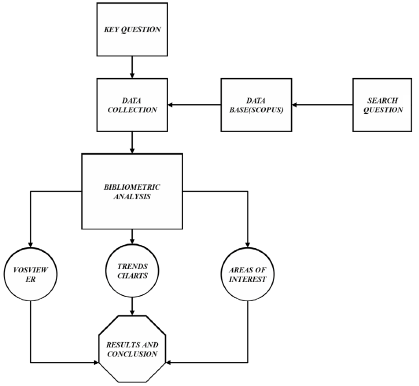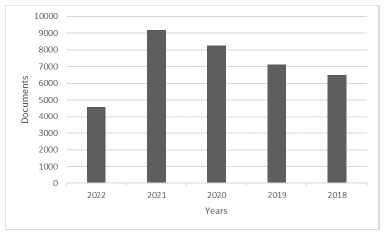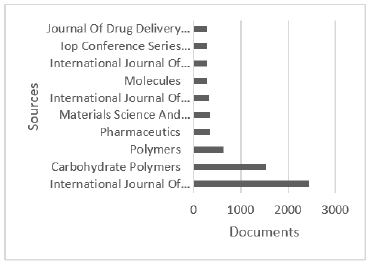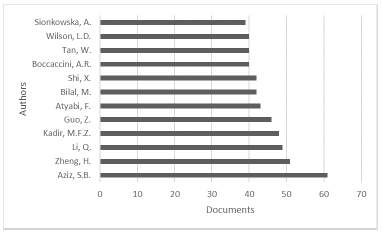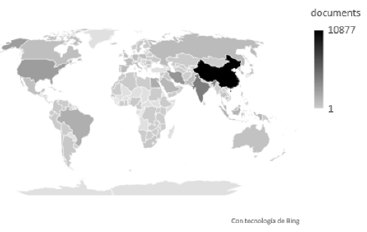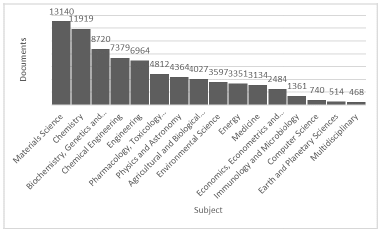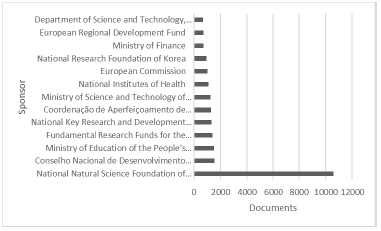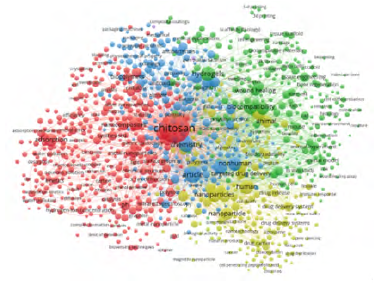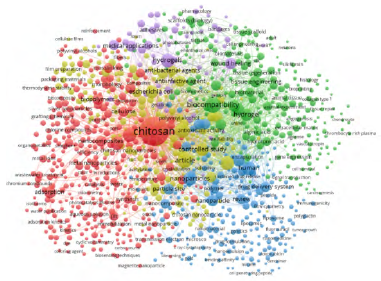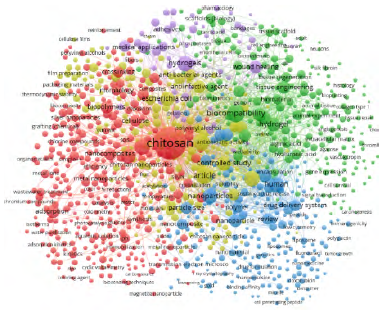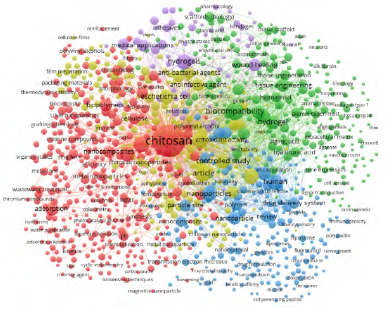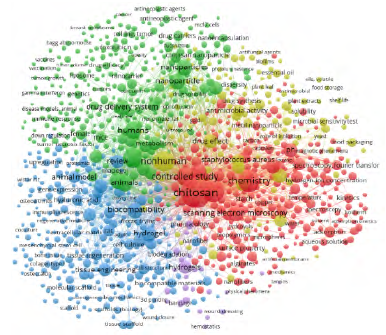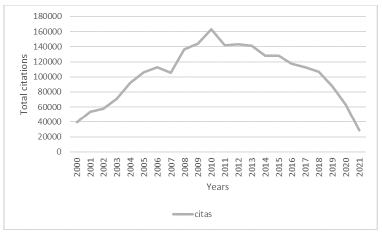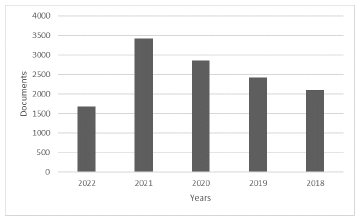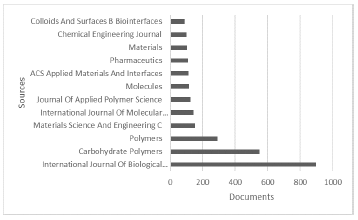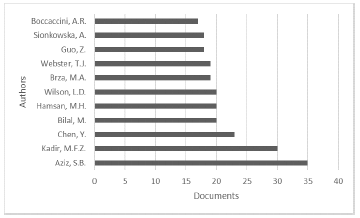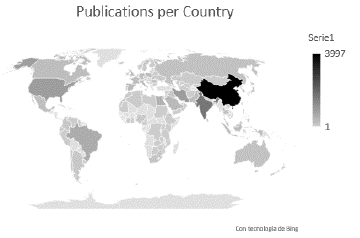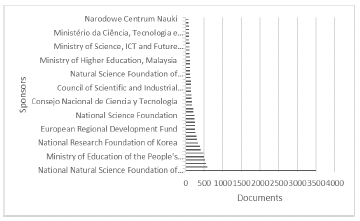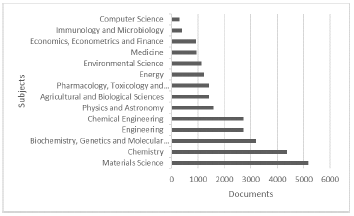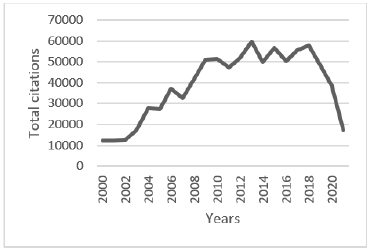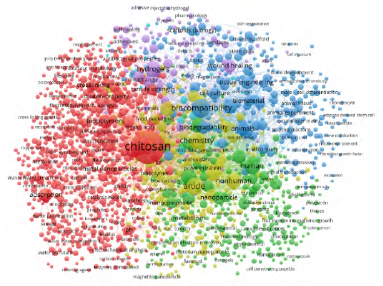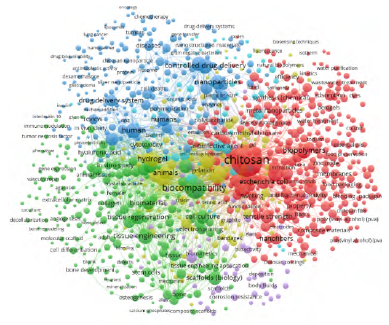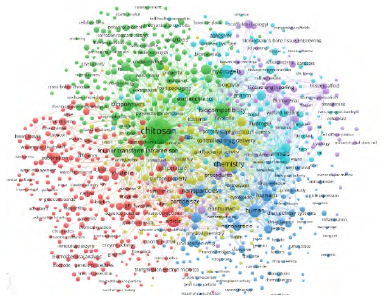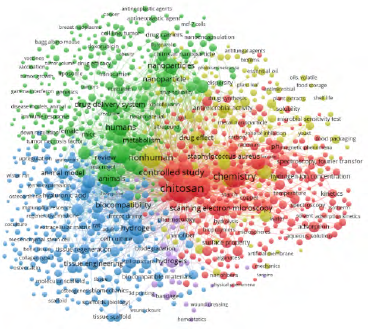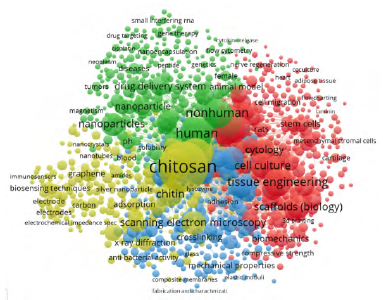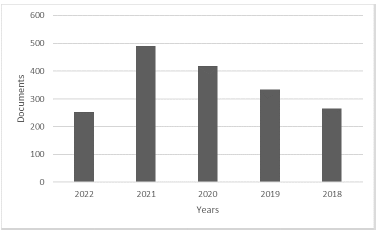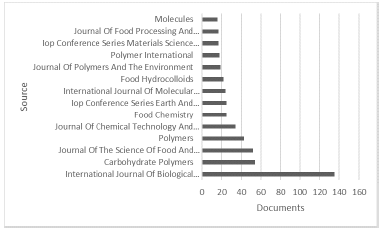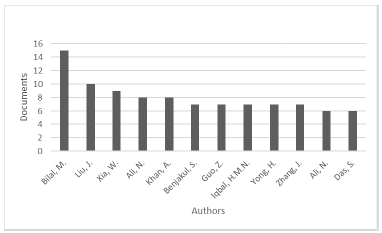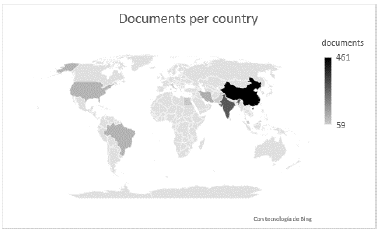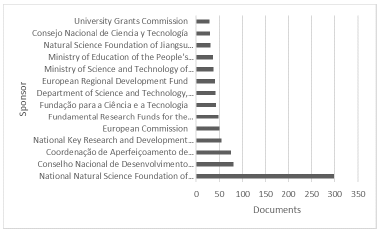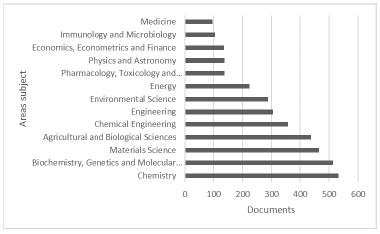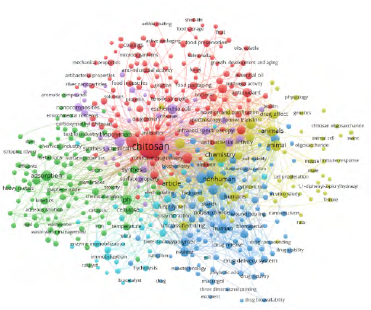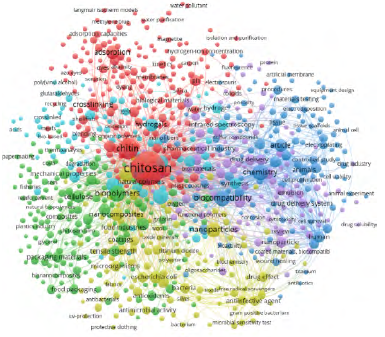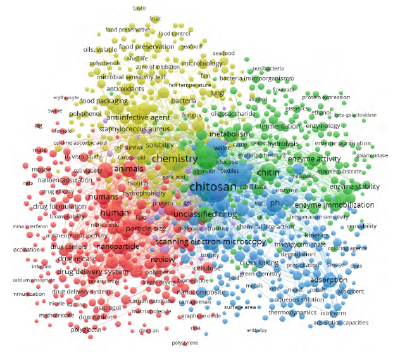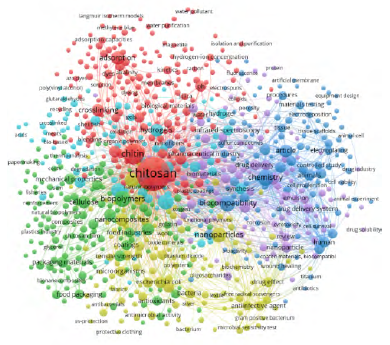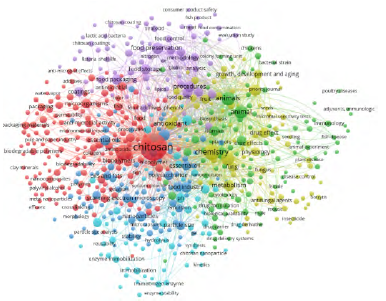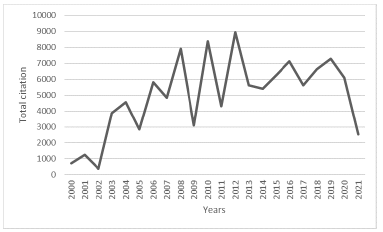Introduction
Chitin is the second most abundant biopolymer in the world [1-4]. This biopolymer is synthesized from numerous natural sources. The (b-(1-4)-N-acetyl-D-glucosamine is produced naturally, forming microfibers giving structure to the exoskeleton of arthropods, however, crabs and shrimp are the main source of chitin, due to its abundance and bioavailability [5-8] Similarly, chitin is available in the cell walls of fungi and yeasts [9,10]. After its identification in 1884 numerous investigations has been developed, with the above it was possible to determine that after deacetylating chitin, chitosan is obtained, another biopolymer, chemically paired with chitin, (poly (β-N-acetyl-glucosamine-co-β- glucosamine)) This material has numerous uses due to its chemical and physical properties, this allows its application in different sectors, such as agriculture, medicine, water treatment, cosmetics, among other industries [11-15]. The impact of chitosan can be seen in the world market, by 2027, the size of the world market is estimated to be about 28.93 billion dollars [16-18]. Therefore, it is important to understand the quantity and quality of the information that allows investigation of the topic. As a result, a bibliometric study must be carried out, in which the studies about chitosan and its application in the industry are analyzed. From databases, it determines the number of documents, the type of documents, the impact according to the number of citations, and the countries where chitosan is most researched.
Key questions
The objective of the study is to determine how much information is available, quantify it and qualify it. Therefore, must answer the following questions:
-Which database contains more information on chitosan?
- What volume of information exists on the application of chitosan?
- What are the most used keywords?
-What is the impact of the documents?
-Which are the countries that investigate the most?
-What kind of documents are the most developed?
-Who are the main authors?
-What are the areas where chitosan research has the greatest impact?
Methods and tools
Methods
Fundamentally, it seeks to understand the research fields of chitosan, the industry, and its applications, therefore the proposed method followed [19-22]. As shown in Figure 1, the questions to be answered are established. Subsequently, the keywords of the research are indicated, chitosan, industry, and application, through databases, different data are extracted that allow, through software, to make visible and analyze to obtain a general overview of the research on chitosan.
Tools
The use of tools is of vital importance to streamline the data collection and analysis process. First of all, the Scopus® database is the one to obtain the data. Additionally, the VOSviewer® program is used. This software is a tool that allows for building bibliometric networks, these networks are formed by documents, linking according to authors, citations, or keywords. The latter, seeks to quantify the main keywords to observe search trends around chitosan. Finally, the data is analyzed using analyzed Excel CSV, in this format dynamic tables allow to make the analysis and subsequent interpretation.
Data collection
Now, Scopus® contains more than 24,500 serial titles from more than 5,000 publishers in 140 countries. This database covers 82 million documents, 1.7 billion citations, 17 million author profiles, 234 thousand books, 70 thousand publishers, and 80 thousand institution profiles [23-25]. Likewise, Scopus is the basis of data with greater content worldwide, (50 to 230 % more content per region than the competition [26-28]) Additionally, Scopus® covers the areas of interest for this research, of 100 % of the content, 70 % are documented on physical science, life science, and social science. For this reason, documents in the chemical, physical, engineering, economic and business, biological, and pharmacological areas are abundant [29,30]. On the other hand, according to Tec Validate 86 % of the users report comments that the coverage of their field is broader and more precise compared to the other databases [31]. It is necessary to emphasize Scopus® has different tools which allow extracting data from different documents, for example, “citation overview” and “Journal analyzer”, in addition to using impact metrics such as SCImago journal Rank®, SourceNormalizedImpact per Paper Cite Score and H Index. For all the above was used exclusively the Scopus database.
When a search is made about Chitosan in Scopus®, as a title or abstract keyword, the database has 90,410 documents. From this, it was sought to extract the trends of recent years. As for, the keywords, the areas of interest, the main authors, the main journals, the countries of the greatest research, and the types of documents Subsequently, the most important sub-areas, the keywords, and the main sources of the 2,000 documents with the greatest impact are extracted. In the same way, using the words “chitosan” “industry” and “chitosan” “application”. Respectively is extracted 26,123 and 3,538 documents were obtained Search, which seeks to answer the target questions (Table 1). For it, the total number of publications in 3 cases is sectioned according to keywords, looking to observe the trends in the industry and its application. As such, the three cases were “chitosan” “chitosan + Application” and “chitosan + Industry”.
Table 1 Search equations and number of documents found.
| Column 1 | Search Equation | Documents |
|---|---|---|
| 1 | Chitosan | 90,535 |
| 2 | Chitosan AND (LIMIT-TO (SUBJAREA, “material science”)) | 33,266 |
| 3 | Chitosan AND (LIMIT-TO (SUBJAREA, “Chemistry”)) | 31,058 |
| 4 | Chitosan AND (LIMIT-TO (SUBJAREA, “Biochemistry”)) | 22,221 |
| 5 | Chitosan AND (LIMIT-TO (SUBJAREA, «chemical engineering”)) | 20,811 |
| 6 | Chitosan AND application | 26,194 |
| 7 | Chitosan AND Application AND (LIMIT-TO (SUBJAREA, «material science”)) | 10,835 |
| 8 | Chitosan AND Application AND (LIMIT-TO (SUBJAREA, «chemistry”)) | 8,998 |
| 9 | Chitosan AND Application AND (LIMIT-TO (SUBJAREA, «Biochemistry”)) | 6,727 |
| 10 | Chitosan AND Application AND (LIMIT-TO (SUBJAREA, «engineering”)) | 6,723 |
| 11 | Chitosan AND Industry | 3,549 |
| 12 | Chitosan AND Industry AND (LIMIT-TO (SUBJAREA, “chemistry”)) | 1,146 |
| 13 | Chitosan AND Industry AND (LIMIT-TO (SUBJAREA, “Biochemisty”)) | 997 |
| 14 | Chitosan AND Industry AND (LIMIT-TO (SUBJAREA, “, Material science”)) | 936 |
| 15 | Chitosan AND Industry AND (LIMIT-TO (SUBJAREA, “, Agricultural”)) | 810 |
Bibliometric analysis
Chitosan (case 1)
As stated above, Scopus® has 90,410 documents on chitosan. Now, in recent years, the publications of documents where the keyword chitosan is used can be seen in Figure 2. We can see that the year 2021 has the record for the largest publication of documents dealing with the topic of chitosan, with more than 9,000 documents. On the other hand, the number of documents published per year has been increasing, in 2022, more than 4,500 documents have been published, it may be that at this rate it equals or exceeds the publications of the year 2021.
In Figure 3, the main sources of publication of documents on chitosan are observed. The main source of information is the International Journal Of Biological Macromolecules, with almost 2,500 thousand publications using chitosan in the last 4 years in the abstract titles or keywords. This magazine in the year 2021 is qualified between the quartiles 1, 2, and 3. Followed by Carbohyd Polymers. According to Scymago journal & country Rank®, both journals are from Q1-Q2 quartiles.
Continuing, the authors who have published the most documents dealing with the topic of chitosan in recent years are Aziz, S.B, Zheng, H, and Li, Q, with 61, 51, and 49 publications respectively, which can be seen in Figure 4.
Additionally, can visualize the main research countries, these being China with 10,877 published documents, followed by India with 4,189, and Iran with 2,937 documents Figure 5.
Likewise, the main areas of interest are: the science of materials, with 13,140 published documents, the chemical area with 11,919 documents, followed by the area of biochemistry with 8,720 documents, and finally the area of chemical engineering with 7,379 documents. In Figure 6 we can see the above. Additionally, the main sponsors are, the National Natural Science Foundation of China, the Ministry of Education of the People’s Republic of China, and Fundamental Research Funds for the Central Universities, Figure 7.
Additionally, in Figure 8, the keywords were extracted, and their relationships between the keywords. From it, the main group is found in red, in this, can find words that include chitosan and some of its chemical and physical properties. In the same sense, the main areas of Scopus® were extracted, the keywords. In Figure 9, the most important properties of chitosan are related, in Figure 10 there are groups around tissue engineering. On the other hand, Figure 11 extracts the keywords that relate the chemical element with chemistry and, finally, Figure 12, relates the biochemical aspects of the biopolymer.
From the above, are extract the keywords and their relationship between them, Figure 8-12. In general, the program VOSviewer® report 4 groups of keywords. In red are words like biopolymer adsorption, and cellulose Ph is the first one. This group represents the chemical and physical properties of the elements. In the second group are words relating to the structure, and drug release in yellow we can find, keywords such as particle size, and nanoparticle liposomes drug delivery system. The third group, green, represents important research in chitosan, the tissue engineering Terms like hydrogel, biocompatibility, wound healing, and bone regeneration among others. The final group is the one with the closest proximity to the term chitosan, nevertheless, they aren´t connections as direct as in the other groups, concepts like bacteria, article property, and coating. Additionally this relation between keywords, we extract keywords depending on the Scopus sub-areas. Mainly Material science, engineering chemistry, and Biochemistry. In the sub-area of material science, the aforementioned groups stayed the same. But a new group appears. This one is far from the center showing words, like medical application hydrogels gelation. On the other sub-areas, Chemistry, and biochemistry the trend of the groups is the same. But different from the other areas the existed less relation between the keywords. It means they carry out research and deal with different topics without connection. In addition, in terms of the demand for citations between the years 2000 and 2010, document citations more than doubled, indicating that it was during this period of greatest interest, however, later until 2020 these declined to 40,000 citations per year, Figure 13.
According to the Scopus database, the most cited documents are:
“Chitin and chitosan: Properties and applications” by Rinaudo, Marguerite published Progress in Polymer Science (Oxford) Volume 31 in 2006 cited 5,276 times.
“Porosity of 3D biomaterial scaffolds and osteogenesis” by Karageorgiou, Vassilis; and Kaplan, David, Biomaterials Volume 26, Issue 27 in 2005 cited.
“A review of chitin and chitosan applications” by Ravi Kumar, M.N.V in 2000 Reactive and Functional Polymers by 3,903 times.
“Hydrogels for tissue engineering: Scaffold design variables and applications” by Drury, J.L., Mooney, D.J in 2003 Biomaterials cited 3,807 times.
Chitosan+Application case 2
Previously, the information from Scopus ® are extracted using only the word chitosan, in the same way, the above is done, using the keywords “chitosan” AND “application” from this is obtain 26,145 documents. Publications by year using the above keywords, 2,869 documents were published in 2022, and 3420 in 2021. In 2022, 1,677 documents have been published Figure 14.
Following the above, is obtain results similar to point 3.1, since the new International Journal Of Biological Macromolecules and Carbohydrate Polymers is the main source of documents in Figure 15.
Similarly, in the case of the authors, Aziz, S.B. and Kadir, M.F.Z being the main authors Figure 16.
As in the previous case, seeing the publications according to the ccountry, Figure 17, where China continues to be the country where the majority of documents are published.
Continuing, the largest sponsor for the realization of these documents, is the National Natural Science Foundation of China, followed by the Fundamental Research Funds for the Central Universities and the National Council for Scientific and Technological Development (Figure 18). Now, after extracting the areas of interest, where the subject of materials science, chemistry, biochemical engineering, and chemical engineering, Figure 19. Interestingly, the publications related to the application of chitosan, the citations increase and decrease according to the years, until the year 2008-2009 these tended to increase, however the following years the total citations per year have ranged between 60,000 to 50,000, Figure 20.
As in case 1, the main keywords extracted and related to each other Figure 21 exposes in red, this group is most of the main terms found when searching for chitosan and its applications. Figure 22 determines less well-concerned groups, highlighting the area of biopolymers. Figure 23 has biocompatibility themes as the main group in green. Figure 24, on the other hand, groups keywords on the effect of chitosan and drug delivery system.
Finally, Figure 25 has a main group in yellow in terms of adoption but it can be noted that it also has tissue engineering groups.
From those areas of interest, we extract keywords and using VOSviewer®, the relationship between the most used keywords (Figure 21-25) In the case to use only the word chitosan as a search equation, (Figure 25) there are 5 groups of keywords. The group closest to the search equation is the one in Red. This group looks for the polymer’s relationship with other components such as copper, and crosslinks. Other groups deal with tissue engineering in blue, hydrogels in purple, and nanomaterials in green, In yellow they are words concerning chitosan, but without a clear relationship between them.
Similarly, the most cited documents are:
“Chitin and chitosan: Properties and applications” by Rinaudo, Marguerite published Progress in Polymer Science (Oxford) Volume 31 in 2006 cited 5,276 times.
“Porosity of 3D biomaterial scaffolds and osteogenesis” by Karageorgiou, Vassilis; and Kaplan, David, Biomaterials Volume 26, Issue 27 in 2005 cited.
“A review of chitin and chitosan applications” by Ravi Kumar, M.N.V in 2000 Reactive and Functional Polymers for 3,903 times.
“Hydrogels for tissue engineering: Scaffold design variables and applications” by Drury, J.L., Mooney, D.J in 2003 Biomaterials cited 3,807 times.
Below are the keywords and their relationship with chitosan according to the area of interest.
Chitosan and industry case 3
Another keyword that allows the database to be sectioned to obtain precise information is “industry”. In Scopus, we found 3,540 published documents. As in the previous cases, the number of published documents has increased over the years, in 2018 they published 266 documents, and in 2021, 490 documents were generated increasing by 30 % publications in the 3 years (Figure 26).
In turn, observing the behavior of the main sources where the topic of chitosan and the industry is again, the International Journal Of Biological Macromolecules 134 documents, Carbohydrate Polymers 53 documents, and the Journal Of The Science Of Food And Agriculture 52 documents. (Figure 27).
However, unlike points 4.1 and 4.2, the main authors are Bilal, M., Liu, J., and Xia, W. As shown in Figure 28.
On the other hand, in contrast to the previous points, the region that produces the largest number of documents is China, followed by India and Brazil, Figure 29.
China is the country with the highest number of published documents since the organization the National Natural Science Foundation of China sponsored 298 documents, Other important entities that have sponsored the research are Conselho Nacional de Desenvolvimento Científico e Tecnológico (CNPq) and Coordenação de Aperfeiçoamento de Pessoal de Nível Superior Figure 30.
Continuing, the same trend of the previous points where the main subjects are the chemical area (533 documents), biochemistry (514 documents), and material science (466 documents), but agriculture and biological science appear (438 documents) and the area of chemical engineering (359 documents) Figure 31.
Following the methodology of case 1 and case 2, Figure 32 presents different groups of keywords, in which the food packing sector stands out, Figure 33 (Chitosan+Industry+Chemical area) shows different groups related to each other, but the sector that stands out is that of polymers. In Figure 34, the sector in blue stands out for being mostly related to the word chitosan, presenting some properties of industrial interest. Figure 35 among its groups relates mainly words about the use of chitosan in hydrogels since in this predominant group we find words like “crosslinking” “adsorption”, “hydrogels” and “biological materials” Finally, Figure 36 relates chitosan with biodegradable properties.
In the same way, keywords are a useful tool to find information. But also, relate these concepts to understand what has been investigated and the interested groups. From this, we extract those words and how are they connected in Figures 33-36. The general case (chitosan + industry) reveals that since the use of this search equation is less used there is less connection and less use of certain keywords. For instance, the size of the circles of the keywords is less than that of other case studies. Additionally, the relationship between the groups is lower. We can observe keywords that are not related to any other. Nevertheless, 5 groups are present in all cases (chitosan + industry). The main ones, in red, are words around the concept of the food industry, such as food preservation, packing, etc. Keywords in blue are the concept of the pharmaceutical industry, in yellow are concepts about chitosan in animals, and in green are proprieties and the textile industry.
Finally, the most cited documents are:
Non-conventional low-cost adsorbents for dye removal: A review by Crini, G. Bioresource Technology published in 2006, cited 3,434 times.
A review of potentially low-cost sorbents for heavy metals by Bailey, S.E., Olin, T.J., Bricka, R.M., Adrian, D.D. Water Research published in 1999 cited 2,732 times.
Antimicrobial properties of chitosan and mode of action: A state-of-the-art review by Kong, M., Chen, X.G., Xing, K., Park, H.J. International Journal of Food Microbiology published in 2010, cited 1,797 times.
Chitosan and its use as a pharmaceutical excipient, by Illum, L. Pharmaceutical Research published in 1998 cited 1,334 times.
Therefore, from the total documents, we can extract their impact according to the years (Figure 37).
Interpretation
Documents per year
First, within the database, there are 90,511 documents dealing with chitosan, (case 1) of these 26,160 documents deal with the subject of “chitosan and application” (case 2), that is, 28.9 %. Additional 3,545 documents deal with the subject of “chitosan and industry” (case 3), that is, 4 % of the total. Based on the above, we can determine that there are documents that relate chitosan to direct use in the industry. In turn, from 2018 to 2021, the number of documents published per year continues to increase, in the first case, from 6,495 documents to 4,594, that is, the number of publications increased by 30 %. On the other hand, in case 2 of the chitosan + application, the number of publications increase 62 %, from 2,101 to 3,420 documents. The same happens with the number of publications per year of case 3 chitosan + industry, where in 2018 266 documents were published, and in 2021 490, for which the number of publications grew by 84 %. Therefore, we can understand that there is an interest in the investigation of chitosan, but above all the rapid increase in the number of publications that seek to give it a direct application in the industry.
Authors and sources
For its part, regarding the study of the main authors of 2018 - 2022, we can determine important names by the areas in which they work. Regarding the use of chitosan, are observe that the main author is Aziz, Shujahadeen B., an author with 194 published documents, of these 61 documents deal with chitosan and 35 with chitosan and its application. Of these documents, can find publications, such as “Electrical and morphological analysis of chitosan: AgTf solid electrolyte” cited 95 times. This investigation presents the application of chitosan, as a solid electrolyte polymer, the author, Shujahadeen, is a researcher characterized by his research in material science, therefore those studies check the use of chitosan as a material part of Electrolytes of the polymer mixture. and chitosan membranes [32]. In addition, its properties, such as electrochemistry and plasticity, are studied [33]. Meanwhile, the main source would be the International Journal Of Biological Macromolecules, with a total of 2,440 documents dealing with the subject of chitosan, of this total, 897 are about chitosan and its application, 135 are about chitosan and industry, according to Scimago, most of these articles they fall into the Q2-Q3 quartiles (“International Journal of Biological Macromolecules,” 2022). At the same time, the second source is Carbohydrate Polymers, with 1528 documents, where 550 documents are about chitosan and application and 54 are about chitosan and industry. This source is characterized by its articles in the area of bioplastics, biomaterials, biorefining, chemistry, drug administration, food, health, nanotechnology, packaging, paper, and pharmaceuticals. According to Scimagojr®, the articles in this journal fall into the Q1 quartiles [34]. Another journal of great interest is Polymers with 645 documents of these 289 are about chitosan and application, and 43 are about chitosan and industry. This journal is noted for its articles on polymer synthesis, polymer analysis, polymer theory, simulation, the physics and chemistry of polymers, polymer processes, polymer quality, and polymer application. According to Simagojr®, these articles are from Q1 quartiles [35]. Other sources of information such as journal Pharmaceutical sciences with 347 articles, of these articles, 110 are about chitosan and its application, and 8 are about chitosan and industry. This journal provides documents on scientific advances, technology, and applications around pharmacy and biopharmaceuticals. Scimagojr® rates the articles of this source in the Q1 quartile [36]. Other sources are Chemical Engineering Journal with 245 articles, of which 104 are chitosan and application and 10 are chitosan and industry. In turn, other sources with more than 100 articles published on chitosan, its application, and industry between 2018 and 2022 are, the International journal of pharmaceutics, Materials Science And Engineering C, Journal Of The Science Of Food And Agriculture. Therefore, are observed that the main sources investigate the use of chitosan as a biopolymer and other applications, on the other hand, other sources are found in the agricultural pharmaceutical sector. If we seek to qualify the quality of these articles, is see in most of these journals, according to Scimagojr ® fall into Q1 and Q2, although some articles from the Journal Of Biological Macromolecules are from Q3.
Country and sponsors
Continuing, Figures 4, 16 and 28 observe that most of the names of authors are of Eastern origin, this makes sense since Figures 5, 17 and 29 visualize the countries of greatest research. Therefore, China is at the forefront of research with a total of 10,877 published documents about chitosan, of which 3,997 are about chitosan and application, and 461 are about chitosan and industry. It is followed by India, with 4,189 documents, of these, 1,677 are about chitosan and application and 286 are about chitosan and industry. Subsequently, the third country with the most research about chitosan is Iran with 2,937 documents, of these, 929 are about chitosan and its application, and 117 documents on chitosan and industry. The fact that China is the country with the most research on chitosan and its applications is the result of several factors. The main one is that most of the sponsors are of Chinese origin. The National Natural Science Foundation of China is sponsoring 10,575 of the documents, of which 3,493 are about chitosan and application, and 298 are about chitosan and industry. Other sponsors of Chinese origin are the National Key Research and Development Program of China Ministry of Education of the People’s Republic of China Ministry of Science and Technology of the People’s Republic of China among many others, to which we can affirm that China sponsors around 21 percent cent of the papers surrounding chitosan research and its applications in industry. On the other hand, another factor of interest is the consumption and production of shrimp, with China being the largest consumer in the world, and one of the main ones, along with India [37]. It is therefore that the countries with the most research are the countries that invest the most in research, but, in addition, they are those countries that produce significant quantities of shrimp. Other regions where documents are published would be the United States, with 2,503 documents of these, 859 documents dealing with chitosan and application, and 104 with chitosan and industry. Egypt is another region of importance; this region has published 1,682 articles of these 503 where chitosan and application, in turn, published 65 documents on chitosan and industry. Other important sponsors are Fundamental Research Funds for the Central Universities with 1,483 sponsored documents, Conselho Nacional de Desenvolvimento with 1,554 publication, and Coordenação de Aperfeiçoamento de Pessoal de Nível Superior with 1,316 documents.
Areas of interest
It is important to consider the areas of interest to determine which sectors are the most developed articles, VOSviewer® allows us to extract the first 1,000 keywords by area and totals. First of all, in Figure 9 we can see 4 main groups of keywords. In the center is chitosan, the main keywords directly connected with the said word, nanocomposites, adsorption, biopolymers, PH, Metal nanoparticles, synthesized, cellulose. In another group, connected, we find words like the article, chemistry, nonhuman, targeted drug property, antioxidants, and antibacterials. Another sector can be extracted words like nanoparticles/nanoparticles, human drug release, polymers, and drug Carrier [38-41]. In the last group, they’re words such as hydrogels, biocompatibility, wound healing, tissue engineering, and medical applications [42-44] These groups refer to the main areas. At the same time, it is possible to dimension the main studies, around the medical area, materials science, biochemistry, and chemistry, by keywords. Similarly, in case 2, chitosan and application, we found the main areas of interest. These are materials science, chemistry, biochemistry, and chemical engineering. Now, if we extract only the general keywords, we can find the following, biopolymers, biocompatibility, Hydrogel, tissue regenerations, tissue engineering, biomaterial, controlled drug delivery, and nanoparticles among others. In turn, in the case of searching for chitosan and industry, the main areas of interest are chemistry, biochemistry, material science, and agriculture. In Figures 10, and 11 those graphs with fewer keywords, the main ones being chitosan, chemistry, nonhuman adsorption, nanocomposites, wastewater management textile industry biopolymers. Therefore, from the three cases studied, the main keywords are around the study of biopolymers, hydrogel, chitosan biocompatibility, tissue regeneration, water treatment, and application of tissue engineering. On the other hand, in the three cases, the main areas of research are material science, chemistry biochemistry, and engineering, more specifically chemical engineering, however, when searching for chitosan and industry, another area of interest would be agricultural and biological science [45-47].
A second time, of the documents that develop research around chitosan, we found that 37 % of the documents are from the “Material Science” area. In Figure 10, 5 groups of keywords are presented. Main keywords like chitosan, biopolymers, waste treatment, chitosan nanoparticles, nanocomposites, adsorption, and cellulose. The other larger group found keywords such as hydrogel biocompatibility, tissue engineering, tissue regeneration, and biomaterial. In another smaller group, are nanocomposite nanoparticles, human, drug delivery systems, and particle size issues. The last two groups are connected by topics such as hydrogel, medical application, wound healing escherichia coli, and antiinfective agent. In the application of chitosan, the area of material science represents 41 %. Unlike only the word “chitosan” it is only divided into 4 main groups, Figure 21, in terms of the area of material science, the chitosan + application group can make visible 5 groups of keywords. The main ones are keywords like biopolymers tensile strength antibacterial activity metal nanoparticles wastewater treatment nanofibers. In the second group, is observe words such as biocompatibility, tissue regeneration, and tissue engineering cell culture. The third group is find, controlled drug delivery nanoparticles, human drug delivery system, and humans. In the fourth group, we can see words like hydrogel, gelation, animals, bandages, and mice. Finally, in the smallest group, we find glass electrode bioactivity chitosan coatings. However, in the case of the chitosan + industry, the area of material science represents 26 % of the published documents. From this area, in Figure 21 the main keywords connected with chitosan are chitin, adsorption, biopolymers, chemistry, Ph, nanoparticles, cellulose, pharmaceutical industry chemistry, hydrogels, biocompatibility, and cellulose. After this, the investigation of the materials science area is one of the most developed, being the most investigated are the main one for case 1 (chitosan) and for case 2 (chitosan application), and in third place (chitosan industry). On the other hand in this area, the common keywords in these groups are, biopolymers, biocompatibility, tissue regeneration.
In a third point, another area where more research is done is Subject chemistry, this represents 33 % of the documents published in case number 1. From these documents, certain keywords come back and appear, such as biopolymers, chemistry, biocompatibility, adsorption, tissue engineering, and hydrogels. Within case 2, (chitosan + application) the subject chemistry, represents 35 % of the documents. As in the previous case, most of the keywords from the previous point reappear, such as biocompatibility hydrogels biopolymers Fourier transform, and tissue engineering anti-infective agent [48-50]. In turn, this area is the most researched, it represents 30 % of the documents. In this case, the main keywords are the article PH adsorption, chemistry, and textile industry biopolymers.
In a fourth point, the third most studied area in the first case is genetic and molecular biological biochemistry, with 33 % of documents, the main keywords are, controlled study, chemistry, PH, hydrogels nanoparticles, tissue engineering, tissue, regeneration, chitosan nanoparticles, PH to a lesser extent the words biopolymers and hydrolysis appear. In case 2, the area of genetic and molecular biological biochemistry is the third area of interest, 26 % of the documents revolve around the subject. Of these documents, the main keywords are, article, controlled study, anti-infective agent, PH, and tissue engineering biocompatibility. In case 3 (chitosan and industry) this area is the second most investigated 29 %. Of these documents, the main keywords are Chemistry, PH solubility human, chitin, unclassified drugs, and review.
A fifth point, the fourth area of greatest research, is the chemical engineering sector with 21 % documents, in the first case (chitosan). Of these, the keywords are less connected, than in the past points, Figure 32. Of these keywords, the main ones are, article scanning electron microscopy, polymer, chemistry, hydrogel, cell culture, and tissue engineering. In the second case (chitosan application), engineering and chemical engineering represent 22 % of these, the relevant keywords would be, tissue engineering, cytology, nanoparticles, scanning electron, chitin, and adsorption. In the third case, (chitosan industry), the engineering area represents 17 % of the documents, being the sixth most researched area, and the fifth area is chemical engineering. The main keywords are controlled study, pH, adsorption, wastewater management, chemistry, enzyme biocompatibility, and chemical industry. On the other hand, the fourth area investigated is agricultura and biological sciences, with 25 %, unlike the other two cases, it would be the eighth area. Within the documents that enter the area of agriculture and biological science, the main keywords would be, again, adsorption, chemical industry, biopolymers algae Ph, enzyme immobilization, enzyme activity, biocompatibility, and chemistry.
From all of the above, the focus of the research is in the areas of material science, biochemistry, chemistry, chemical engineering, and Agricultural and Biological Sciences. Other areas of interest are Environmental Science, Pharmacology, Toxicology and Pharmaceutics, Medicine, and Earth and Planetary Sciences. In turn, the keywords show that chitosan is related to numerous uses in the pharmaceutical industry, for example, the keywords more relevant can find tissue regeneration and hydrogel for example. Other applications investigated are water treatment, the creation of new materials, and polymer biopolymers, also in the chemical industry, medical applications, and applications in the agricultural industry [5,1-55].
Main documents and citations
To determine the impact of an article, the number of times a document has been cited is quantified. In case 1, articles from 2000 to 2022 have been cited more than 2,279,511 times. The year where the articles had the greatest impact was 2010 with almost 162,740 times cited in that year. In 2007, the number of times the documents were cited decreased. After the boom in 2010, the impact of the case 1 documents quickly diminished. As a result, in 2021 the documents were cited 28,948 times. The most cited article is “Chitin and chitosan: Properties and applications” by Rinaudo, Marguerite published Progress in Polymer Science (Oxford) Volume 31 in 2006 cited 5,276 times. This article presents the state of the art of chitosan, from its morphology, its physical and chemical properties, and its characterization identification methods, such as the degrees of deacetylation, and its molecular weight. Additionally, I present a different application for chitin and chitosan. Now, in case 2 (chitosan and application) the documents have been cited more than 856,481 between the years 2000 and 2013 the articles were cited from 12,382 to 59,594 times. The year 2013 was the year where these investigations had the most impact. Subsequently, the documents lost relevance, to just 260 citations in 2021. As in case 1, the document with the highest citation was “Chitin and chitosan: Properties and applications.” Finally, case 3 (chitosan in the industry). These documents have been cited more than 109,586 times). The year 2012 was the year whose published documents had the greatest impact with a total of 8,963 times cited. The movement of graph 38 is erratic, after a year with many citations the following year the number of times a document is cited decreases, in recent years the impact of these documents has decreased if compared to the year 2012. Now, in this case, the article with the greatest impact is “A review of potentially low-cost sorbents for heavy metals”. Developed by Bailey, S.E., Olin, T.J., Bricka, RM, Adrian, D.D. published in 1999, the source is Water Research. This article presents the use of chitosan as a low-cost adsorbent as a replacement for current expensive methods to remove heavy metals from the solution. Another article of interest antimicrobial properties of chitosan and mode of action: A state of the art review. The Authors are Kong, Ming Chen, Xi Guang, Xing, Ke, Park, Hyun Jin. Published in 2010 in the International Journal of Food Microbiology. this journal is show how, due to the chemical and biological properties of chitosan, it can be used as an antimicrobial agent, thanks to its high biodegradability, non-toxicity and antimicrobial properties (Azmana et al., 2021; Denise Prado Almeida et al., 2022; el Knidri et al., 2018; Kong et al., 2010).
Conclusion
Finally, chitosan is a material of interest in different industry segments. Scopus®, one of the main databases worldwide, has 90,535 documents, of these, 28.9 % are directly related between chitosan and its application, it also, describes the process and extraction, and 6 % of chitosan study was financially supported by industry. Additionally, the journals that have published the most documents are the International Journal Of Biological Macromolecules, Carbohydrate Polymers, Chemical Engineering Journal, International Journal of Pharmaceutics, Materials Science and Engineering, C, Journal Of the Science Of Food and Agriculture. In the case of the Journal Of Biological Macromolecules, being the journal with the largest number of published articles, enter quartiles 1, 2, 3. The other sources mentioned are Q1. Additionally, the countries of greatest investigation are from China, 10,877 documents published between 2018 - 2021. Of these, 3,997 are about chitosan and application, and 461 are about chitosan and industry. Likewise, most of the sponsors that have invested in documents dealing with the application of chitosan are of Chinese origin, the largest being the National Natural Science Foundation of China, sponsoring between 2018 and 2022, 10,575 of the documents, of these 3,493 are about chitosan and application, and 298 about chitosan and industry. Now, the main areas of interest, in case 1, are Material science, chemistry, biochemistry, and chemical engineering. Of these, the main keywords used are chitosan, biopolymers, waste treatment, chitosan nanoparticles, nanocomposites, adsorption, cellulose, such as hydrogel biocompatibility, tissue engineering, tissue regeneration, and biomaterial. Similarly, in case 2 the main areas of research are material science, chemistry, biochemistry, and engineering, on the other hand, in case 3 the areas are chemistry, biochemistry, material science and agroindustry. From these areas is observed that the application of chitosan is heavily investigated, in polymeric, medical, and agro-industrial industries. Now, the different publications have had a strong impact, 227,951 times the articles have been cited between 2000 and 2021 in case 1, in case 2, 856,481 times, and in case 3, 109,586 times. Finally, there is an interest in the industrial applicability of chitosan, the main areas of interest are around the use of the material as a polymer, in the agricultural, pharmaceutical, and water treatment industries.













